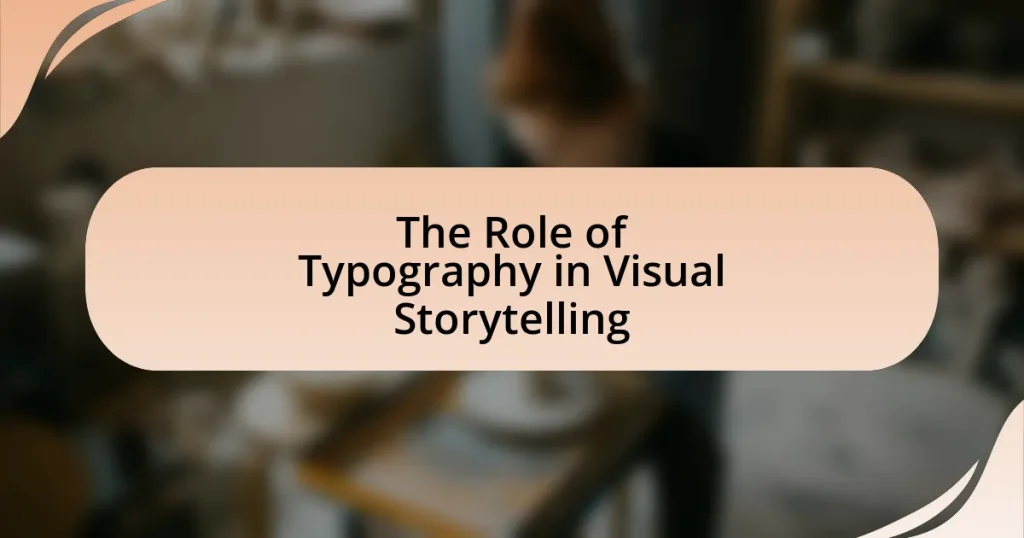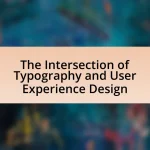Typography is a fundamental element in visual storytelling, significantly impacting how narratives are perceived and understood. It influences emotional responses through font choice, size, spacing, and color, shaping the tone and readability of the text. The article explores the various types of typography, including serif and sans-serif fonts, and their respective roles in conveying tradition, modernity, and emotional depth. Additionally, it discusses best practices for integrating typography with imagery, the importance of maintaining hierarchy, and common mistakes to avoid, ultimately highlighting how effective typography enhances audience engagement and comprehension in visual narratives.
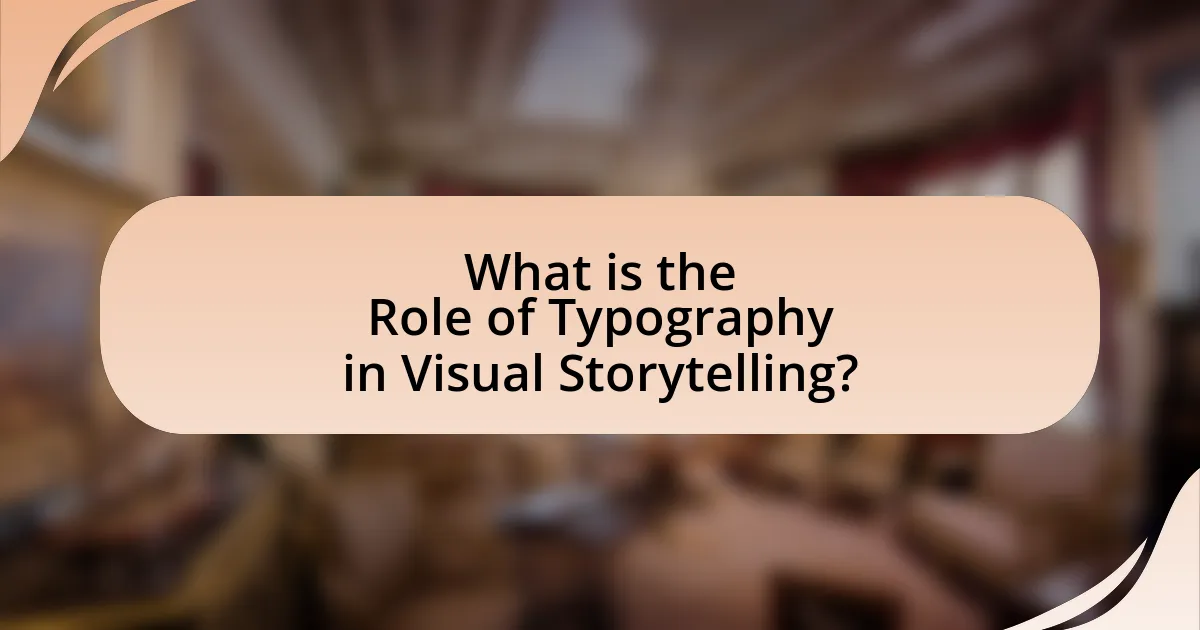
What is the Role of Typography in Visual Storytelling?
Typography plays a crucial role in visual storytelling by enhancing the narrative and emotional impact of the content. It influences how the audience perceives and engages with the story, guiding their attention and evoking specific feelings through font choice, size, spacing, and color. For instance, a bold, sans-serif font can convey strength and modernity, while a delicate script font may evoke elegance and nostalgia. Research indicates that typography can affect readability and comprehension, which are essential for effective storytelling. A study published in the journal “Information Design Journal” by authors like Kevin Larson and Julie Friedman, highlights that well-chosen typography can significantly improve user experience and retention of information, thereby reinforcing the overall message of the visual narrative.
How does typography influence the perception of a story?
Typography significantly influences the perception of a story by shaping the emotional tone and readability of the text. Different typefaces evoke distinct feelings; for example, serif fonts often convey tradition and reliability, while sans-serif fonts can suggest modernity and simplicity. Research indicates that the choice of typography can affect comprehension and retention of information, as seen in a study by Tinker (1963), which demonstrated that certain font styles enhance reading speed and understanding. Thus, typography not only affects aesthetic appeal but also plays a crucial role in how a narrative is interpreted and understood by the audience.
What elements of typography contribute to storytelling?
Typography contributes to storytelling through elements such as font choice, size, spacing, and color. Font choice sets the tone and mood of the narrative; for instance, serif fonts often convey tradition and reliability, while sans-serif fonts suggest modernity and simplicity. Size influences hierarchy and emphasis, guiding the reader’s attention to key points. Spacing, including line height and letter spacing, affects readability and pacing, impacting how the story flows. Color can evoke emotions and highlight important themes, enhancing the overall narrative experience. Research indicates that these typographic elements significantly affect reader engagement and comprehension, reinforcing the importance of typography in effective storytelling.
How do font choices affect emotional responses?
Font choices significantly affect emotional responses by influencing perceptions of tone, mood, and personality. For instance, serif fonts often evoke feelings of tradition and reliability, while sans-serif fonts can convey modernity and simplicity. Research by the University of Reading found that typeface can alter the perceived emotional tone of a message, with certain fonts eliciting stronger emotional reactions than others. This demonstrates that typography plays a crucial role in visual storytelling by shaping audience engagement and interpretation.
Why is typography considered a visual language?
Typography is considered a visual language because it conveys meaning and emotion through the design of text. The arrangement, style, and size of type can influence how a message is perceived, similar to how spoken language conveys information. For example, different typefaces evoke distinct feelings; a serif font may suggest tradition and reliability, while a sans-serif font can imply modernity and simplicity. This relationship between form and meaning is supported by research in visual perception, which shows that typography affects readability and emotional response, thereby enhancing the storytelling aspect of visual communication.
What are the key components of typography as a visual language?
The key components of typography as a visual language include typeface, size, line length, spacing, alignment, and color. Typeface refers to the design of the letters, which can convey different emotions and messages; for example, serif fonts often appear more traditional, while sans-serif fonts are seen as modern. Size affects readability and hierarchy, with larger text typically drawing more attention. Line length influences how easily text can be read; optimal line length is generally considered to be between 50 to 75 characters. Spacing, including letter spacing (kerning) and line spacing (leading), impacts the overall clarity and aesthetic of the text. Alignment, whether left, right, centered, or justified, affects the visual flow and organization of the content. Lastly, color can evoke emotions and highlight important information, making it a crucial element in typography. These components work together to enhance communication and storytelling in visual media.
How does typography communicate tone and mood?
Typography communicates tone and mood through the selection of typefaces, sizes, spacing, and colors, which evoke specific emotional responses. For instance, serif fonts often convey tradition and reliability, while sans-serif fonts can suggest modernity and simplicity. The use of bold or italic styles can emphasize urgency or importance, influencing how the message is perceived. Research indicates that typeface characteristics can significantly affect reader emotions; for example, a study published in the journal “Psychological Science” by Timothy J. O’Brien and colleagues found that fonts can alter the perceived credibility of information. Thus, typography serves as a powerful tool in visual storytelling, shaping the audience’s emotional experience and interpretation of the content.
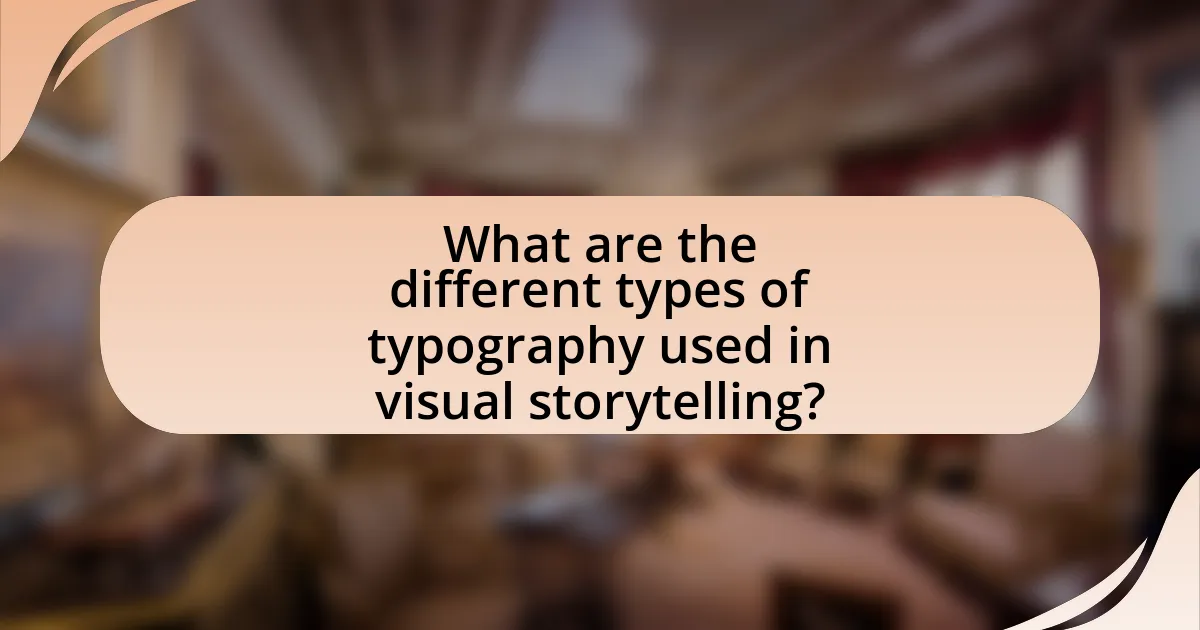
What are the different types of typography used in visual storytelling?
The different types of typography used in visual storytelling include serif, sans-serif, script, display, and monospace fonts. Serif fonts, characterized by small lines at the ends of characters, convey tradition and reliability, making them suitable for print media. Sans-serif fonts, lacking these embellishments, offer a modern and clean appearance, often used in digital formats for readability. Script fonts mimic handwriting and add a personal touch, frequently utilized in invitations or branding. Display fonts are designed for attention-grabbing headlines, while monospace fonts, where each character occupies the same horizontal space, are commonly used in coding and technical contexts. Each type serves a specific purpose in enhancing narrative and emotional impact within visual storytelling.
How do serif and sans-serif fonts differ in storytelling?
Serif and sans-serif fonts differ in storytelling primarily through their emotional and visual impact. Serif fonts, characterized by their small decorative lines at the ends of letters, evoke a sense of tradition, formality, and reliability, making them suitable for storytelling that aims to convey authority or historical context. In contrast, sans-serif fonts, which lack these embellishments, present a modern, clean, and approachable aesthetic, often used in narratives that prioritize clarity and simplicity. Research indicates that serif fonts can enhance readability in printed materials, while sans-serif fonts are often preferred for digital content due to their legibility on screens. This distinction influences how audiences perceive and engage with the narrative, as the choice of font can subtly guide emotional responses and interpretations of the story being told.
What emotions do serif fonts evoke in narratives?
Serif fonts evoke feelings of tradition, reliability, and sophistication in narratives. These fonts, characterized by their small decorative lines at the ends of strokes, are often associated with printed literature and formal communication, which can instill a sense of trust and authority. Research indicates that serif fonts are perceived as more legible and easier to read in long texts, enhancing the reader’s emotional engagement with the narrative. A study by the University of Reading found that serif fonts can evoke a sense of warmth and familiarity, making them effective in storytelling contexts where emotional connection is crucial.
How do sans-serif fonts enhance modern storytelling?
Sans-serif fonts enhance modern storytelling by providing clarity and readability, which are essential for effective communication. Their clean lines and lack of embellishments allow for quicker comprehension, making them ideal for digital media where attention spans are shorter. Research indicates that sans-serif fonts are perceived as more modern and approachable, which aligns with contemporary storytelling techniques that aim to engage diverse audiences. For instance, studies show that text presented in sans-serif fonts can improve reading speed by up to 10% compared to serif fonts, thereby facilitating a smoother narrative flow. This increased readability supports the overall goal of storytelling: to convey messages clearly and effectively.
What role does typography play in branding within visual storytelling?
Typography plays a crucial role in branding within visual storytelling by establishing a brand’s identity and conveying its message effectively. The choice of typeface, size, and spacing influences how audiences perceive a brand’s personality, values, and emotions. For instance, a bold sans-serif font may communicate modernity and strength, while a serif font can evoke tradition and reliability. Research indicates that 90% of the information transmitted to the brain is visual, highlighting the importance of typography in creating memorable brand experiences. Additionally, consistent typography across various platforms reinforces brand recognition, as seen in successful brands like Coca-Cola and Apple, which utilize distinct typefaces to maintain a cohesive visual narrative.
How does typography contribute to brand identity?
Typography significantly contributes to brand identity by establishing a visual language that communicates a brand’s personality and values. The choice of typeface, size, spacing, and color can evoke specific emotions and associations, influencing how consumers perceive the brand. For instance, a luxury brand may use elegant serif fonts to convey sophistication, while a tech company might opt for modern sans-serif fonts to suggest innovation. Research indicates that consistent typography can enhance brand recognition by up to 80%, reinforcing the brand’s message across various platforms. This alignment between typography and brand identity helps create a cohesive and memorable experience for consumers.
What are examples of effective typography in branding?
Effective typography in branding includes the use of distinct typefaces that convey a brand’s personality and values. For instance, Coca-Cola employs a unique script font that evokes nostalgia and happiness, reinforcing its identity as a classic beverage brand. Similarly, Google uses a clean, sans-serif typeface that reflects modernity and accessibility, aligning with its mission to organize information universally. Additionally, the luxury brand Chanel utilizes an elegant serif font that communicates sophistication and exclusivity. These examples demonstrate how typography can significantly influence brand perception and recognition.
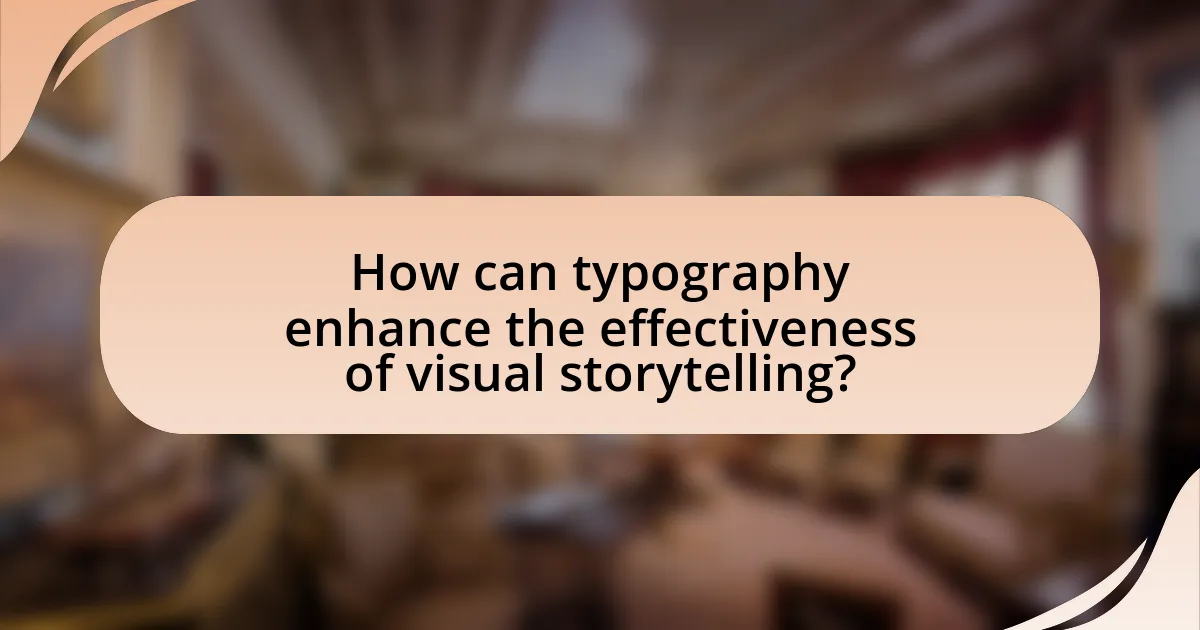
How can typography enhance the effectiveness of visual storytelling?
Typography enhances the effectiveness of visual storytelling by establishing tone, guiding viewer attention, and improving readability. The choice of font style, size, and color can evoke specific emotions and set the narrative mood, as seen in studies where serif fonts are associated with tradition and reliability, while sans-serif fonts convey modernity and simplicity. Additionally, typography can direct the viewer’s focus through hierarchy and spacing, ensuring that key messages stand out, which is crucial in visual media where quick comprehension is necessary. Research indicates that well-designed typography can increase information retention by up to 40%, demonstrating its significant impact on audience engagement and understanding in visual storytelling.
What techniques can be used to integrate typography into visual narratives?
Techniques to integrate typography into visual narratives include layering text with imagery, using contrasting fonts for emphasis, and employing dynamic text placement to guide viewer attention. Layering text with imagery enhances storytelling by creating a cohesive visual experience, as seen in graphic novels where text and illustrations work together to convey emotion and context. Contrasting fonts can highlight key messages, making them stand out, which is evident in advertising campaigns that utilize bold typography against softer backgrounds to draw focus. Dynamic text placement, such as curving text along a path or positioning it within the flow of images, directs the viewer’s gaze and enhances narrative flow, a technique frequently used in motion graphics and animated storytelling.
How does hierarchy in typography guide viewer attention?
Hierarchy in typography guides viewer attention by organizing text elements in a way that emphasizes their importance and facilitates comprehension. This is achieved through variations in size, weight, color, and spacing, which create a visual structure that directs the reader’s gaze. For instance, larger and bolder fonts typically indicate headings or key points, drawing immediate focus, while smaller, lighter text is often used for supplementary information. Research by the Nielsen Norman Group highlights that users scan web pages in an F-pattern, where they pay more attention to the top and left areas of the page, reinforcing the need for effective typographic hierarchy to capture and maintain attention.
What are the best practices for combining typography with imagery?
The best practices for combining typography with imagery include ensuring contrast, maintaining hierarchy, and aligning styles. Contrast between text and background enhances readability; for instance, using light text on a dark image or vice versa improves visibility. Maintaining a clear hierarchy through font size and weight guides the viewer’s attention, allowing them to discern the most important information first. Additionally, aligning typography styles with the imagery’s tone—such as using serif fonts for traditional themes and sans-serif for modern aesthetics—creates a cohesive visual narrative. Research indicates that effective typography can increase comprehension by up to 50%, demonstrating its critical role in visual storytelling.
What common mistakes should be avoided in typography for storytelling?
Common mistakes to avoid in typography for storytelling include using too many font styles, which can create visual clutter and distract from the narrative. Consistency in font choice is crucial; varying fonts can confuse readers and disrupt the flow of the story. Additionally, poor contrast between text and background can hinder readability, making it difficult for the audience to engage with the content. Overly small font sizes can also alienate readers, as they may struggle to read the text comfortably. Lastly, neglecting proper spacing, such as line height and letter spacing, can lead to a cramped appearance, further detracting from the storytelling experience. These mistakes can significantly impact the effectiveness of typography in conveying a narrative.
How can poor typography detract from a story’s message?
Poor typography can significantly detract from a story’s message by creating confusion and misinterpretation among readers. When text is poorly designed—such as using hard-to-read fonts, inappropriate sizes, or inadequate spacing—it can lead to distractions that prevent the audience from fully engaging with the narrative. Research indicates that legibility and readability are crucial for effective communication; for instance, a study published in the Journal of Visual Literacy found that readers’ comprehension decreased by 30% when presented with poorly formatted text. This demonstrates that typography directly influences how well a story is understood and appreciated, ultimately affecting its impact.
What are the signs of ineffective typography in visual storytelling?
Ineffective typography in visual storytelling is indicated by poor readability, inconsistent font usage, and lack of hierarchy. Poor readability occurs when text is difficult to read due to font choice, size, or color contrast, which can hinder audience comprehension. Inconsistent font usage disrupts visual cohesion and can confuse viewers, as multiple fonts may clash or distract from the narrative. Lack of hierarchy, such as not using varying font sizes or weights to distinguish between headings and body text, results in a flat visual experience that fails to guide the viewer’s attention effectively. These signs collectively undermine the intended message and impact of the visual story.
What practical tips can improve typography in visual storytelling?
To improve typography in visual storytelling, use a limited font selection, maintain consistent spacing, and ensure high contrast between text and background. A limited font selection, ideally two to three complementary fonts, enhances readability and visual coherence. Consistent spacing, including line height and letter spacing, aids in guiding the viewer’s eye and improving overall flow. High contrast, such as dark text on a light background or vice versa, ensures legibility and draws attention to key messages. Research indicates that effective typography can increase information retention by up to 40%, underscoring its importance in visual communication.
How can one choose the right font for a specific narrative?
To choose the right font for a specific narrative, one must consider the tone, genre, and emotional impact of the story. For instance, a whimsical narrative may benefit from a playful, rounded font, while a serious historical account might require a more traditional serif font to convey authority and reliability. Research indicates that font choice can significantly influence reader perception; a study by T. S. B. and J. M. in “The Psychology of Typography” found that fonts evoke different emotional responses, affecting engagement and comprehension. Therefore, aligning the font with the narrative’s intent enhances storytelling effectiveness.
What resources are available for learning typography best practices?
Books such as “The Elements of Typographic Style” by Robert Bringhurst and “Thinking with Type” by Ellen Lupton are essential resources for learning typography best practices. These texts provide foundational knowledge on typographic principles, including hierarchy, spacing, and font selection. Online platforms like Skillshare and Coursera offer courses specifically focused on typography, allowing learners to engage with practical exercises and expert insights. Additionally, websites like Typewolf and Fonts In Use showcase real-world applications of typography, providing inspiration and context for best practices. These resources collectively support a comprehensive understanding of typography in visual storytelling.
